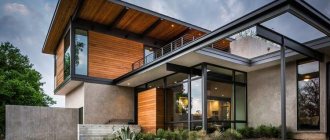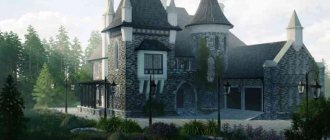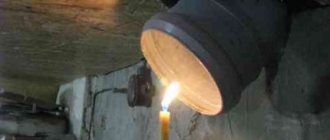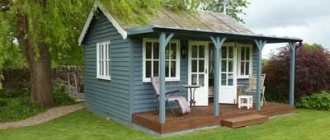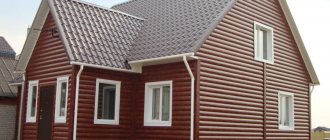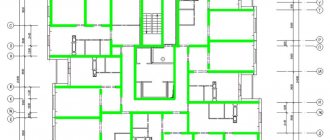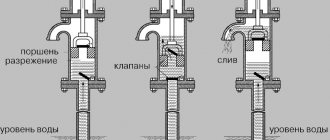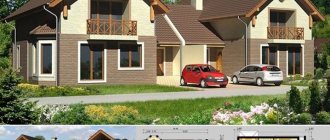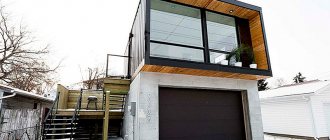Good morning! What buildings did you see on your way to work? If you travel by transport, you see at least 10 houses. And most likely more. And each house is built in a certain architectural style, it’s not for nothing that there is such diversity in our cities, well, except for residential areas.
Architectural style is the commonality of certain characteristics in one building. This could be the columns, the shape of the windows or the materials used. The style is usually tied to a particular era, such as Gothic or Art Nouveau.
It includes the purpose of the building, decorative elements, functional elements, composition, design and construction and cladding materials. And today I will show you what styles there are in architecture with examples.
Romanesque
In terms of chronology, we could start with antiquity, but we will see that later. A conscious architectural school began in the 9th century with the Romanesque style. These are typical medieval castles, fortress walls and other city buildings.
You can recognize it by the lack of decoration, narrow loophole windows, monumentality, narrow passages and thick walls. Architects of the Middle Ages were just learning how to make vaults and ceilings that would support a heavy roof and even several floors.
Think of castles: Romanesque style will have towers and columns. In Russia, buildings of this style can only be seen in Vyborg and other fortresses of the Middle Ages.
Gothic
In the 12th century, architects learned to build reliable vaults, and the church wanted luxury. This is how the Gothic style appeared. Gothic tends to the sky: it seems that the height of the building is several times greater than its width, although in fact it could be the other way around.
In fact, you won’t be able to avoid recognizing Gothic, but just in case, here’s a list of signs:
- Stained glass;
- Round window in the center and towers on each side;
- There is an abundance of decor, but it all falls into two categories: something very sharp, like icicles upside down, and something about torment in hell;
- Material – stone;
- Monumentality, then in general, if they built it, then it was something for a thousand people;
- Pointed arches, vaults, but apart from them all the guides are strictly vertical.
Something like this, the most common example is Notre Dame Cathedral, everyone has seen it at least in a photo. In Moscow and St. Petersburg you can see Gothic, but in other cities you need to look for it.
Varieties
Windows, more than other elements, shape the personality of a home; Not only the appearance, but also the interior of the home depends on them. This applies doubly to large windows for a private home; variants of which form several types.
Unusual shape Source archello.s3.eu-central-1.amazonaws.com
Classic (panoramic)
Designs with a large glazing area, when the entire wall (or a significant part of it) is made transparent. The name speaks for itself - the panorama is located in a prime location and demonstrates a picturesque view of the surrounding area. Such windows give the room a presentable appearance, occupy space in the facade wall from floor to ceiling, and their width significantly exceeds the height.
On the top floor Source luculentia.ru
Standard window options in a private house are suitable for rooms on the upper floors if there is a beautiful view from there (this option is especially suitable for a house on a slope). The location on the ground floor will be successful if there is a forest, pond, well-kept garden or swimming pool next to the house.
Two paintings Source static.deccoria.pl
Bay windows
The bay window, an original architectural element, itself serves as a decoration for the house. Supplemented with a panoramic window, it becomes the highlight of the facade and invariably attracts attention. A bay window panorama increases the comfort of living as it increases access to natural light.
Winter morning Source loveincorporated.blob.core.windows.net
The panorama can be performed both around the entire perimeter and on one of the bay walls. Since bay windows are usually small in size, continuous glazing does not lead to significant heat losses. The cost of winter maintenance of a room with a bay window increases slightly.
In the recreation area Source green-house23.ru
Corner
The most complex version of panoramic structures, when the corner of the facade walls is glazed on both sides; the house acquires special attractiveness and lightness. Such a solution is appropriate for buildings with high ceilings, but care must be taken to compensate for heat loss, which is inevitable for large windows in any house.
In the dining room Source i.pinimg.com
An angular panorama is implemented in several ways:
- Frameless design. Fastening to window openings is carried out using special corner profiles, using a special welding technology. A transparent sealant is used to connect the glass sheet.
- Profile. Corner window shapes for the home can use frames made of wood, aluminum, PVC, fiberglass, or combined (aluminum-wood). The corners are joined in the standard way.
- With amplification. A column or stationary profile is mounted in the corner part, then frames with double-glazed windows are attached.
With a sea view Source data.whicdn.com
In the office Source decoratorist.com
French windows
There is a mistake in this name: French windows are large (panoramic) floor-to-ceiling doors. There are two types of French windows and doors: with sliding or hinged sashes. The design of the latter lacks an impost - a reinforced profile between the sashes.
In the backyard Source i.ytimg.com
French window design in private homes is at the peak of popularity. Elegant windows and doors are usually designed on the ground floor. Here they serve as a spectacular exit to the garden, to the pool or to another room (for example, a winter garden). A beautiful architectural solution is to connect a living room or bedroom with a terrace (veranda).
Convenient solution Source s3.amazonaws.com
If a French window is installed on the top floor, a protective structure is mounted in front of it on the facade, imitating a balcony railing. This façade element, although it does not have its own balcony area, is called a French balcony.
A look from the inside Source st.hzcdn.com
With access to the terrace Source st.hzcdn.com
See also: Catalog of companies that specialize in designing country houses
Renaissance
When the luxury of Gothic began to become boring, this came already in the 15th century, they remembered the ancient world. Well, as we remembered, we found a couple of successful dilapidated cities in Italy and the idea began to spin.
They wanted to return that beautiful, regal severity and tranquility, while the buildings had decorations and, in principle, could not be monumental; the townspeople were already fed up with the scale.
The main thing that I would like to note in favor of human engineering is the use of materials other than stones and decorative plaster to improve houses outside and inside.
You can recognize it by the columns, especially if you remember the order system, horizontal orientation, ideal proportions, including in the top plan: the building will be square, rectangular or C-shaped, no sudden angles. Porticoes, pediments and other decorations from antiquity are added, as well as statues and bas-reliefs.
Exterior decor
The classical style in modern architecture is characterized by the following decorative elements:
- snow-white columns decorating the entrance group;
- large balconies;
- antique pediments;
- figured balustrades and parapets;
- protruding interfloor cornices;
- exquisite platbands;
- ornamental bas-reliefs (meanders, leaves, palmettes, rosettes);
- ground floor, finished with decorative stone.
In urban environments, a “lightweight” version of the classics is often used, in which columns are replaced by half-columns or pilasters, and stucco molding and bas-reliefs give way to emphatically strict platbands, cornices and corner decor.
Classicism
In fact, it is the successor of the Renaissance, but it came into fashion only in the 17th century, after the Baroque. This is the most accurate adaptation of antiquity to a non-antique climate. There is strictness, lines, columns, porticoes and all this.
Due to the universality of the style, its beauty and good compatibility with other houses in cities, classical buildings were often built in Russia until Soviet times.
How things work in practice
There is such a thing as restoration windows. This is a window structure consisting of two blocks, external and internal:
- External window block
. Double-glazed window (standard double-chamber), two insulation circuits, fittings. Its main function is to fit perfectly into the architectural appearance of a historical building, due to the accurate imitation of a restoration window. - Internal window block
. It is made in an antique style, equipped with fittings in the appropriate historical style, in harmony with the interior design of the premises.
Depending on the specific historical architectural object, both blocks can be either the same (identical) or different.
If you need to carry out such serious work as installing PVC windows in a historical building, contact only reliable, proven manufacturers with a good reputation.
Empire style
By the 18th century, everyone was already tired of both classics and baroque. I wanted something new. Or old. The architects took and modified the Romanesque style, taking into account time and possibilities. And they didn’t forget about the classics, they have proven themselves well. By the way, in Russia it has developed into the Stalin Empire style.
How to find out? Let's take the classics, remove the hint of the Greeks and add a military theme. We will get a minimum of decorations, and those that remain are military ones, columns, strict simple windows. And all this is massive, monumental, as if we were building a castle.
Yaroslavl
An example of a classic here would be Sovetskaya Square, namely the building of the Provincial Government Offices. Built in 1787 in record time per year. This is the first such monumental building in Yaroslavl, because it is the main government building of a large center, they could not have built it otherwise.
On Pervomaiskaya Street you can find Gostiny Dvor. Built in the first quarter of the 19th century to replace the open market. He suffered from fires, reconstruction and shelling during the Second World War. The entire historical concept can no longer be seen, but the rotunda and the preserved northern wing will help you see and understand classicism.
Romanticism
By the end of the 18th century, an incredible number of scientists, writers appeared, and in general life became similar to modern life. Urban estates appeared, people wanted to live beautifully.
And then they decided to use metal in architecture, and there was very little time left before concrete. In general, Romanticism allowed many cheap houses to be built, something that no other style had allowed before.
You can recognize it by its disregard for straight lines and the laws of symmetry. It is believed to have been born from Gothic. But such, mini-gothics. Imagine a gingerbread house from a fairy tale - it will be romanticism. Most likely with a turret, 1-3 floors high, nicely decorated. With balconies and bay windows.
Where did window architecture begin?
Every person, probably, at least once in his life wondered how, by whom and when the first window opening was made? The earliest mention of the window dates back to the 2nd millennium BC.
It is connected with the ancient Semitic myth about a gift presented by the supreme god to one of the rebellious minor gods: Baal Zebul, the god of thunder, fire and fertility, (by the way, the prototype of Beelzebub - the devil in the biblical tradition) was strong, brave and dexterous. In some skills, he competed with the Supreme God. For his immoderate pride, the Supreme God obliged him to live on Earth among people, for which purpose he built a golden castle with silver ornaments for him. In addition, the Supreme God made a window in the castle wall.
This was the first window opening in the history of civilization, which received the names: “eye of God” (window), “eye of the wind” (window). Humanity highly appreciated the first opening of the window, but a means of protection against the aggression of the external environment was not immediately found.
Photo: images of the Golden Mam Baal Zebul have not survived to this day. But ancient people could well have used natural openings in cave vaults as windows. For example, such “Eyes of God”, as in the Prohodna cave in Bulgaria, © bgtravel.bg
Modern
Here we are already in the 20th century, almost modernity. The architects said: to hell with the rules, look what nature can do! And they created houses with smooth lines, lack of symmetry and natural ornaments. You will not confuse the result with anything.
A special feature is the elaboration of the interior decoration. These are not apartments that are sold with white walls. Here the interior fits perfectly with the exterior, or rather vice versa, because the house was built around the right rooms.
Constructivism
And here are our apartments. Constructivism arose in Soviet times, when it was necessary to quickly and cheaply provide apartments for cities with a population of over a million.
This is a typical building, where there is practically no decoration, and all the architecture is based on functionality. The most common construction was apartment buildings, I myself am writing from one of them.
Deconstructivism
Where there is simplicity and convenience, something complex and unusual inevitably arises. Just a couple of photos so you understand, it’s difficult to explain the style, which I would call “against all odds.”
High tech
You can still see buildings in the high-tech style in private buildings; they look futuristic, unusual, but in terms of comfort they are not for everybody. There are modern technologies, plenty of glass and ease of use.
Each country has its own architectural styles, local architects changed them to suit the weather conditions, culture and other characteristics of their country. This is how Catherine's Baroque, neo-Russian and Russian styles appeared. Let's take a quick look at Russian architecture.
Further reading[edit]
- Sir John Summerson (1980 version) The Classical Language of Architecture
ISBN 978-0-500-20177-0. - Gromort Georges (Author), Richard Sammons (Introductory Essay). Elements of Classical Architecture (Classical America in Art and Architecture series), 2001, ISBN 0-393-73051-4.
- OpenSource Classicism is a project of free educational content about classical architecture
- Fundamentals of Classical Architecture, Part Two: Greek Classicism - ICAA Free Education Program (Published August 29, 2022)
| vteHistory of architecture | |
| |
| |
← § →
Eclecticism
When the capitals stood in classicism and baroque, they began to build eclecticism. This style involves a combination of any architectural styles and their details, contrary to logic.
An openwork column with a strict pediment? Why not! Marble sculpture against a glass display case? And other unusual solutions.
Other neo
The prefix “neo” implies a rethinking of the old style, adding modern materials, design solutions and national characteristics. There is neo-Gothicism, neoclassicism and others; a lifetime would not be enough to list them all. The main thing is that in neo-styles the original style is visible.
Studying architecture is something that people spend years on. This is a very interesting topic, especially if you study it in the context of one city. How was the Romanesque style changed for a village in England? How did classicism behave in the Far East? What happened to Art Nouveau in Voronezh? But all these are dissertation topics, and it’s time to finish for today.
Alla was with you, an amateur guide to the main cities of Russia.
